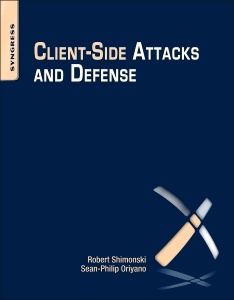Description
Client-Side Attacks and Defense
Language: English
Subjects for Client-Side Attacks and Defense:
296 p. · 19x23.4 cm · Paperback
Description
/li>Contents
/li>Readership
/li>Biography
/li>Comment
/li>
Chapter 1: Background on Attacks
Chapter 2: A Closer Look at Client-Side Attacks
Chapter 3: A History of Web Browsers
Chapter 4: The Problem with Browsers
Chapter 5: Exploring and Exploiting Active Content
Chapter 6: Browser Defenses
Chapter 7: E-mail Client Attacks
Chapter 8: E-mail Client Defenses
Chapter 9: Web Applications
Chapter 10: Web Applications and Client Defenses
Chapter 11: Other Client-Side Attack Targets
Chapter 12: Malware
Chapter 13: Client-Side Countermeasures
Chapter 14: The Road Ahead
Penetration testers; security consultants; system and network administrators; IT auditors
Sean is an experienced content developer and technical writer who has published articles on the IT and Information Security fields. Sean counts IBM, Amazon, Autodesk, and Microsoft among his clients. Sean publishes content regularly and publishes this information on his web site at www.oriyano.com and shares his knowledge in his classes and lectures.
Sean is a member of EC-Council, InfraGard, and BECCA.
Robert Shimonski is a technology executive specializing in healthcare IT for one of the largest health systems in America. In his role at Northwell Health, Rob is a decision maker and strategy planner for information systems operations and technology services. In his current role, Rob is responsible for bringing operational support into the future with the help of new technologies such as cloud and Artificial Intelligence. He is a best-selling author and editor with over 15 years’ experience developing, producing, and distributing print media in the form of books, magazines, and periodicals. Rob’s professional experience includes work for CompTIA, Entrepreneur Magazine, Microsoft, McGraw-Hill Education, Cisco, the US National Security Agency, and Digidesign. Rob has a diverse background in the publishing, including roles such as author, co-author, technical editor, copy editor, and developmental editor. Since print media shifted to the digital doma
- Design and implement your own attack, and test methodologies derived from the approach and framework presented by the authors
- Learn how to strengthen your network's host- and network-based defense against attackers' number one remote exploit—the client-side attack
- Defend your network against attacks that target your company's most vulnerable asset—the end user
These books may interest you

Web SecurityA WhiteHat Perspective 105.47 €

Web SecurityA WhiteHat Perspective 264.58 €


